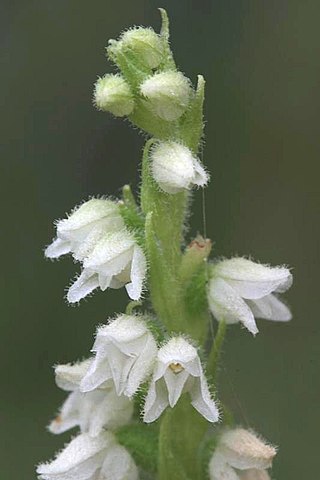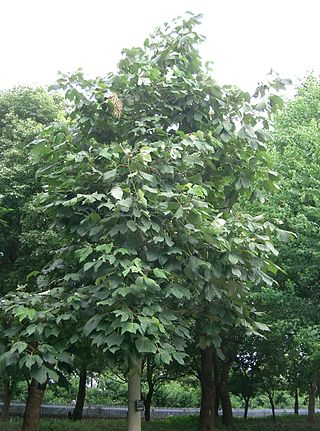
Orchids are plants that belong to the family Orchidaceae, a diverse and widespread group of flowering plants with blooms that are often colourful and fragrant. Orchids are cosmopolitan plants that are found in almost every habitat on Earth except glaciers. The world's richest diversity of orchid genera and species is found in the tropics.

Cypripedium is a genus of 58 species and nothospecies of hardy orchids; it is one of five genera that together compose the subfamily of lady's slipper orchids (Cypripedioideae). They are widespread across much of the Northern Hemisphere, including most of Europe and Africa (Algeria), Russia, China, Central Asia, Canada the United States, Mexico, and Central America. They are most commonly known as slipper orchids, lady's slipper orchids, or ladyslippers; other common names include moccasin flower, camel's foot, squirrel foot, steeple cap, Venus' shoes, and whippoorwill shoe. An abbreviation used in trade journals is "Cyp." The genus name is derived from Ancient Greek Κύπρις (Kúpris), an early reference in Greek myth to Aphrodite, and πέδιλον (pédilon), meaning "sandal".

The Orchidoideae, or the orchidoid orchids, are a subfamily of the orchid family (Orchidaceae) that contains around 3630 species. Species typically have a single (monandrous), fertile anther which is erect and basitonic.

Rhynchospora colorata, also known as starrush whitetop, white star sedge and white-topped sedge, is a perennial flowering plant in the sedge family. It has white bracts, giving it the appearance of white petals with long, green points. It is native to southeastern North America, from Virginia west to New Mexico in the United States, and south into the Caribbean islands.

Prasophyllum, commonly known as leek orchids, is a genus of about 140 species of flowering plants in the orchid family, Orchidaceae and is found in Australia and New Zealand. The Australian species are found in all states but have not been recorded in the Northern Territory. The common name arises from their having a hollow, leek- or onion-like leaf. Some species only flower after summer fires and have flowers similar to those of Xanthorrhoea which flower at the same time, suggesting that they employ the same pollinating insects. Leek orchids are similar to those in the genus Genoplesium except that the free part of the leaf is cylindrical and the labellum has a solid connection to the column. They range in size from the little laughing leek orchid at about 15 cm (6 in) to the king leek orchid which grows up to 2 m (80 in) tall.

Goodyera, commonly called rattlesnake plantain, jade orchids or ladies' tresses is a wide-ranging genus of orchids in the tribe Cranichideae. About 100 species of Goodyera have been formally described. With a center of diversity in East Asia, Goodyera is found across Europe, Madeira, North and Central America, Australia, and on islands from the west Indian Ocean to the Pacific Ocean. They have a rosette of leaves at their base and usually many small white resupinate flowers. They are similar to orchids in the genus Spiranthes but can be distinguished from them by the shape and colour patterns of the leaves.

Firmiana is a genus of flowering plant in the family Malvaceae, formerly placed in the now defunct Sterculiaceae; it may sometimes be called the "parasol tree". The genus name honours Karl Joseph von Firmian.

Chrysaora colorata (Russell), commonly known as the purple-striped jelly, is a species of jellyfish that exists primarily off the coast of California from Bodega Bay to San Diego. The bell (body) of the jellyfish is up to 70 cm (2.3 ft) in diameter, typically with a radial pattern of stripes. The tentacles vary with the age of the individual, consisting typically of eight marginal long dark arms, and four central frilly oral arms. It is closely studied by scientists due to not much being known about their eating habits. A 15-foot-long specimen has been seen.
Crassula colorata, the dense pigmyweed or dense stonecrop, is an annual plant in the family Crassulaceae. The species is endemic to Australia, occurring in Western Australia, South Australia, New South Wales and Victoria.

Aston Rowant National Nature Reserve is located on the north-west escarpment of the Chiltern Hills, in the Chilterns Area of Outstanding Natural Beauty. It has an area of 159.1 hectares, and most of it is a 128.5 hectares biological Site of Special Scientific Interest. It is listed as a Grade 1 site in A Nature Conservation Review. The reserve is in several sections, mostly in the parish of Lewknor in Oxfordshire, with smaller sections in the parish of Stokenchurch in Buckinghamshire.

Arthrochilus, commonly called elbow orchids, is a genus of about fifteen species of flowering plants from the orchid family (Orchidaceae) and is found in Australia and New Guinea. The flowers are pollinated by male thynnid wasps which attempt to mate with the flower and are held in place by hooks while the pollinium is transferred between insect and flower.

Calochilus, commonly known as beard orchids, is a genus of about 30 species of plants in the orchid family, Orchidaceae. Beard orchids are terrestrial herbs with a single leaf at the base of the plant, or no leaves. Their most striking feature is a densely hairy labellum, giving rise to their common name. Beard orchids, unlike some other Australian orchids, do not reproduce using daughter tubers, but self-pollinate when cross-pollination has not occurred. Most species occur in Australia but some are found in New Zealand, New Guinea and New Caledonia.
Warreopsis is a genus of flowering plants from the orchid family, Orchidaceae. It contains 4 known species, native to southeastern Central America and to northwestern South America.

Silvorchis is a genus of flowering plants from the orchid family, Orchidaceae.
P. colorata may refer to:
Epipogiinae is an orchid subtribe in the tribe Nervilieae.
Silvorchis aurea is a species of myco-heterotrophic flowering plants in the orchid family, Orchidaceae. It is endemic to northern Vietnam. It was first described as Vietorchis aurea, the only species in the genus Vietorchis.

Salep, also spelled sahlep or sahlab, is a flour made from the tubers of the orchid genus Orchis. These tubers contain a nutritious, starchy polysaccharide called glucomannan. Salep flour is consumed in beverages and desserts, especially in the cuisines of the former Ottoman Empire, notably in the Levant where it is a traditional winter beverage. An increase in consumption is causing local extinctions of orchids in parts of Turkey and Iran.
Caladenia colorata, commonly known as coloured spider-orchid, small western spider-orchid and painted spider-orchid is a plant in the orchid family Orchidaceae and is endemic to South Australia and possibly Victoria. It is a ground orchid with a single hairy leaf, and usually a single creamy-green flower with blood-red or purple-brown markings and with dark tips on the petals and sepals.













